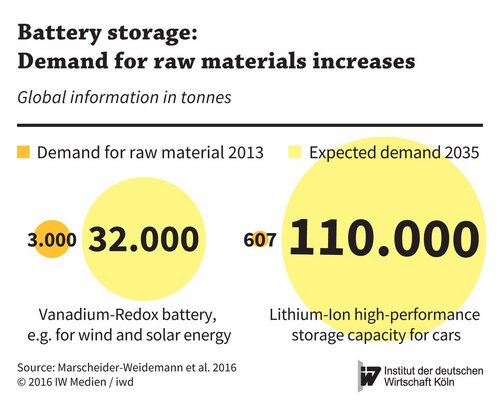Battery storage could go mainstream with growing shares of power produced from wind and sun and electric cars becoming more common in the streets. A rapid growth of the role of rechargeable batteries would, however, also lead to a significantly higher demand for certain critical raw materials needed to build these batteries. If e-vehicles penetrate the market by 2035 global annual demand for lithium could be almost 4 times higher than its current production.

German Energy turn-around – Energiewende: Electricity looking for storage
Until 2050 Germany wants to produce at least 80 percent of its electricity from renewable energy sources; up from the around one third it already reaches today. Wind and sun, however, deliver sometimes more sometimes less electricity – a challenge for electricity grids and their operators. An interesting option of balancing the fluctuations between demand and supply is storage. There are already a number of different technologies in use but all come with one or the other disadvantage:
Pumped storage plants are today essentially the only way to store large amounts of energy cost efficiently. They pump water into a basin on a higher level, store it there and release it again when needed turning it into electricity via a generator connected to a turbine.
Compressed air storage is, in the mid-term, another option. This technology compresses air into sub-terrestrial caverns. The compressed air then can propel a turbine to produce electricity. This, however, is only useful for storing energy for some hours or at maximum up to a day. In addition, the for compressed air storage technology is limited. What is lacking, is long-term storage, capable of bridging longer phases of winds not blowing and little sunshine.
Power-to-gas could fill this gap. This technology transforms water into hydrogen or possibly further into methane. The advantage is that hydrogen – with certain limitations – and methane can both be transmitted, stored and transported in and via the gas networks and reconverted into electricity if needed. The disadvantage of this technology: it is still very expensive.
Batteries have the disadvantage that their production needs so called critical raw materials – critical because there are scarce and need to be imported into countries who are poor in natural resources, like Germany.
Lithium-Ion batteries have a high energy density, are rechargeable and powerful. They currently represent the most promising option for energy storage in electric vehicles. The problem: in 2013 the global demand for lithium for electric vehicles was 607 tonnes – in 2035 it could be almost 200 times higher. If lithium batteries are to be used in the power sector too, the demand would increase even more.
Vanadium-Redox-flow batteries have a lower energy density but can store energy longer than lithium batteries making them suitable to store wind and solar energy. If until 2035 the global storage capacity of these batteries, which currently is under 1 gigawatt hour (GWh), would be ramped-up to 220 GWh, the annual demand for the scarce material vanadium would increase ten-fold.
Storage thus is not a cure-all. To guarantee a functioning and stable electricity system in the future, further flexible technologies and procedures are needed. This includes the temporary use of fossil-fuel power plants, an active demand response management for industrial electricity users, grid extensions and cross-border trading of electricity.

Energiewende: Wie steht es um die Versorgungssicherheit in Deutschland?
In einem Sonderbericht kommt der Bundesrechnungshof zu dem Ergebnis, dass der Ausbau der erneuerbaren Energien zu langsam vorankommt, die Energiewende nicht auf Kurs sei und damit sei auch die sichere Versorgung mit Strom in Deutschland gefährdet. Darüber ...
IW
IMP-Index: Eisenerzschwäche kaschiert festen Markt
Das Preisniveau für die wichtigsten Industriemetalle verzeichnete im März einen leichten Anstieg gegenüber dem Vorjahr, schreibt IW-Geschäftsführer Hubertus Bardt in einem Gastbeitrag für die Börsen-Zeitung.
IW